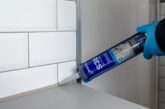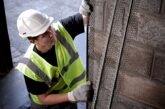
Preparation is the key to successfully plastering difficult surfaces, according to Bostik.
Refurbishment and renovation projects offer a raft of challenges for a tradesperson. It can be part of what makes these jobs more interesting as they often enable you to stretch your problem-solving muscles. Plastering on these projects will often mean dealing with a variety of substrates. It’s time consuming and costly when these jobs go wrong, so preparing your surfaces properly is vital.
The most important thing to do first is assess the substrate and ensure you have a sound background. For instance, if sections of the substrate are flaking off when you tap it, your plaster will ultimately fail – the combination of a high suction substrate and high temperature will affect the new plasterwork and your hard work will have been wasted. Ensure all loose material is removed and the surface is free of dust, then use scrim tape over any joints or cracks.
Sometimes the removal of the old coverings will have unearthed potential problems. There could be remnants of old paints, wallpaper adhesive residue or previous plastering work that cannot be entirely removed. If walls have been knocked down or moved, there could now be two different surfaces next to one another. The challenge is to get even suction control, as substrates that absorb moisture at different rates are more prone to problematic issues, including cracking, air pockets and delamination.
While priming is almost always recommended before plastering, it is even more crucial for some surfaces. PVA is the most commonly used substance for priming, although a smooth and successful finish becomes harder to achieve when plastering onto these problematic substrates. Yet it’s vital to create a uniform surface to ensure even drying times across the entire area.
Further preparation is therefore needed for difficult substrates. For non-porous substrates like smooth concrete, meshing can be installed. The entire surface can also be abraded with sandpaper to offer a better key. Alternatively, many plasterers opt to use a primer that contains sand.
However, there are a number of things to keep in mind when considering a product with sand mixed in. The sand can make a mess on sites because a certain amount inevitably flies off the brush during application, so you should ensure the surrounding area is well covered and factor in time to tidy up afterwards. Perhaps most frustratingly, the weight of the sand will cause it to continually fall to the bottom of the mixture. As a result, the solution must be thoroughly and repeatedly mixed to ensure an even distribution. If not, the key will be patchy and uneven, and when the plaster is put on it will fail to consistently adhere, so this extra work is essential. Even then, the results are not guaranteed as the sand will absorb moisture from the plaster, so there remains a risk of cracking. Also, sand is a harsh aggregate so there is a risk of it dragging through the plaster, leaving lines in the finish.
An alternative is a specifically formulated plasterer’s primer that was developed by professional plasterer, Kev Lindow.
Tasked with half the plastering work during the renovation of two large tower blocks, the patchwork of different substrates gave varying degrees of absorption. The newly applied plaster therefore dried at different rates, leaving Kev with ongoing concerns about drying rates and getting a good key. Even with a team behind him, he found it slow going with so much time spent preparing the substrates. Kev began experimenting with various solutions that could give the great suction control and uniform key that he needed, eventually perfecting a formulation that would make his work easier – and faster.
![]()
In Bostik Plasterer’s Stabilising Primer, Kev has designed a primer that creates an ideal key for re-skimming, with patented PLASPRIME technology that uses recycled plastic. Unlike sand, the plastic isn’t a coarse aggregate and is lightweight enough to stay in suspension throughout the tub, remaining evenly distributed. As the primer doesn’t have to be mixed at all, the plasterer can plaster faster. It’s also more efficient because there is no need to wait for the perfect tack – the primer can be left to dry completely, then plastered any time afterwards, which is useful when working on larger areas. As it’s green in colour, it’s easy to see exactly where you’ve primed too.
It’s worth investing in these specialist primers when they can save you time and make the job easier.
With attentive surface preparations, and the right primer, you will be well positioned for successful plastering onto the variety of difficult substrates encountered during repair or renovation, maintenance and improvement projects.
For more information on Bostik Plasterer’s Stabilising Primer visit https://www.bostik.com/uk/en/catalog/product/construction/emea/uk/bostik-plasterer’s-stabilising-primer/







